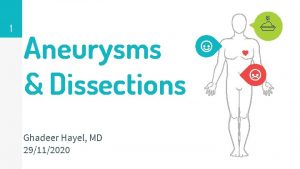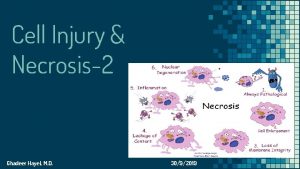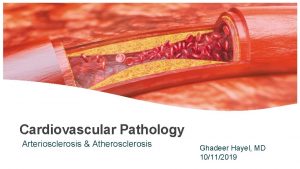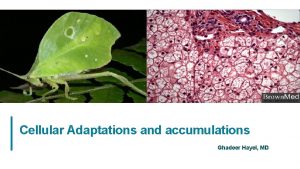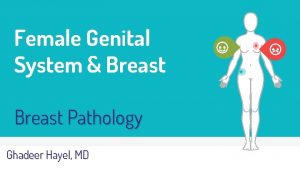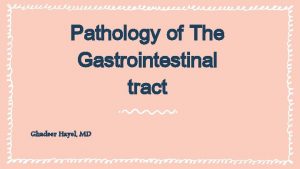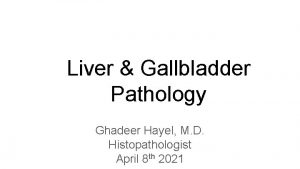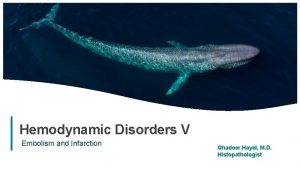1 Aneurysms Dissections Ghadeer Hayel MD 14112019 Aneurysms





















- Slides: 21

1 Aneurysms & Dissections Ghadeer Hayel, MD 14/11/2019

Aneurysms ▹ A congenital or acquired dilations of blood vessels or the heart, could be: 1. “True” : all three layers of the artery (intima, media, & adventitia) or the wall of the heart; e. g. atherosclerotic, congenital vascular aneurysms, ventricular aneurysms after MI 2. “false” : a wall defect leads to the formation of an extravascular hematoma that communicates with the intravascular space (“pulsating hematoma”)

Aneurysms – Types by shape ▹ Saccular aneurysms: discrete outpouchings ranging (5 -20 cm) in diameter, often with a contained thrombus. ▹ Fusiform aneurysms: circumferential dilations up to 20 cm in diameter, most commonly involve aortic arch, abdominal aorta, or iliac arteries.

Aneurysms – Pathogenesis Alterations in SMCs or ECM compromise structural integrity of the arterial media 1. Inadequate or abnormal connective tissue synthesis: many rare inherited ▹ ▹ diseases with abnormalities that can lead to aneurysm formation, aneurysms in these patients easily rupture, even when small: Marfan syndrome: defective synthesis of scaffolding protein fibrillin ↑TGF-β activity weak of elastic tissue dilation in the aorta. Ehlers- Danlos syndrome IV: Defective type III collagen synthesis weak vessels aneurysm formation.

Aneurysms – Pathogenesis 2. The balance of collagen degradation and synthesis is altered by inflammation and associated proteases. . Increased matrix metalloprotease expression by macrophages in atherosclerotic plaque aneurysm by degrading arterial ECM. 3. The vascular wall is weakened through loss of smooth muscle cells or the synthesis of noncollagenous or nonelastic extracellular matrix. ▹ Ischemia of the inner media: In atherosclerotic thickening of the intima increases the distance that oxygen and nutrients must diffuse. ▹ Ischemia of the outer media: Systemic hypertension significant narrowing of arterioles of the vasa vasorum (in the aorta)

Aneurysms – Pathogenesis ▹ Medial ischemia may lead to “degenerative changes” of the aorta; Ischemia smooth muscle cell loss scarring and loss of elastic fibers inadequate extracellular matrix synthesis production of increasing amounts of amorphous ground substance (glycosaminoglycan). ▹ Histologically, these changes recognized as cystic medial degeneration

Aneurysms – cystic medial degeneration

Abdominal Aortic Aneurysm (AAA) ▹ Aneurysms occurring as a consequence of atherosclerosis form ▹ ▹ most commonly in abdominal aorta & common iliac arteries. More frequently in men & in smokers & rarely before 50. In the majority of cases, Atherosclerotic plaques compromise the diffusion of nutrients & wastes between vascular lumen & arterial wall deleterious effects on SMCs. Also atherosclerotic lesions Inflammatory infiltrates release proteolytic enzymes ECM degradation Combination of these, the media undergoes degeneration & necrosis arterial wall thinning dilation

AAA- Morphology ▹ AAAs typically occur between the renal arteries & the aortic bifurcation; can be saccular or fusiform & up to 15 cm in diameter and 25 cm in length. ▹ In the vast majority extensive atherosclerosis is present, with thinning & focal destruction of the underlying media. ▹ The aneurysm sac usually contains bland, laminated, poorly organized mural thrombus …can fill much of the dilated segment. ▹ Not infrequently, AAAs are accompanied by smaller iliac artery aneurysms.

AAA- Morphology

AAA- Clinical Manifestations ▹ An abdominal mass (often palpably pulsating) that simulates a tumor, ▹ most cases. Obstruction of a vessel branching off the aorta (e. g. , the renal, iliac, vertebral, or mesenteric arteries), resulting in ischemia to the downstream organs. ▹ Embolism from atheroma(e. g. , cholesterol crystals) or mural thrombus. ▹ Impingement on adjacent structures (e. g. , compression of a ureter or ▹ erosion of vertebrae by the expanding aneurysm). Rupture into the peritoneal cavity or retroperitoneal tissues massive, often fatal hemorrhage.

AAA- Clinical Consequences ▹ The risk for rupture is related to the size of AAAs. (4 cm in diameter or less almost never burst, 4 -5 cm do so at a rate of 1% per year, 11% per year for AAAs 5 -6 cm, & 25% per year for aneurysms >6 cm in diameter. ▹ Aneurysms 5 cm in diameter or larger are managed surgically, (open bypass by prosthetic grafts or with endoluminal insertion of stented grafts. ▹ Timely intervention is critical; (mortality in elective procedures ~ 5%, whereas in emergency surgery after rupture ~ 50%)

Thoracic Aortic Aneurysm Most commonly associated with hypertension, hypertension bicuspid aortic valves, & Marfan syndrome & Manifest with the following signs & symptoms: o Respiratory or feeding difficulties due to airway or esophageal compression, respectively, because of encroachment on mediastinal structures o Persistent cough from irritation of the recurrent laryngeal nerves. o Pain caused by erosion of bone (i. e. , ribs and vertebral bodies). o Cardiac disease due to valvular insufficiency, narrowing of the coronary o ostia, or aortic valvular incompetence. Aortic dissection or rupture.

Aortic Dissection ▹ Aortic dissection occurs when blood separates the laminar planes of the media to form a blood-filled channel within the aortic wall. ▹ Catastrophic if the dissection ruptures through the adventitia & hemorrhages into adjacent spaces. ▹ May or may not be ass. /w radiologically detectable aortic dilation. ▹ two groups ofpatients: (1) Men 40 -60 years with antecedent hypertension (>90% of cases). (2) Younger adults with systemic or localized abnormalities of connective tissue affecting the aorta (e. g. , Marfan syndrome).

Aortic Dissection - Pathogenesis ▹ Hypertension is the major risk factor for aortic dissection. ▹ Narrowing of the vasa vasorum diminished flow through vasa vasorum degenerative changes in ECM & variable loss of medial SMCs, ▹ Abrupt , transient increase in blood pressure, as may occur with cocaine abuse, is also known to cause aortic dissection. ▹ The trigger for the intimal tear is not known in most cases. Nevertheless, once the tear has occurred, blood under systemic pressure dissects through the media along laminar planes.

Aortic Dissection - Morphology mostly the intimal tear marking origin point is found in the ascending aorta within 10 cm of the valve. Dissection plane can extend retrograde toward the heart or distally.

Aortic Dissection - Morphology Dissection plan usually lies between the middle and outer thirds of the media.

Aortic Dissection – Clinical presentation ▹ The classic clinical symptom of aortic dissection is the sudden onset of excruciating tearing or stabbing pain in the anterior chest, radiating to the back between the scapulae, scapulae & moving downward as the dissection progresses. ▹ The most common cause of death is rupture of the dissection into the pericardial, pleural, or peritoneal cavity. ▹ Common clinical presentations stemming from cardiac involvement include tamponade, aortic insufficiency, and myocardial infarction.

Aortic Dissection – Clinical presentation ▹ Aortic dissections generally are classified into two types Proximal lesions (type A dissections), dissections) involving the ascending aorta, with or without involvement of the descending aorta (De. Bakey type I or II, respectively)… Needs rapid diagnosis & institution of intensive anti-hypertensive therapy coupled with surgery. . Worse outcome Distal lesions (type B dissections), beginning beyond the subclavian artery (De. Bakey type III) … Mostly can be managed conservatively. . Better outcome; 75% survival rate whether they are treated with surgery or with antihypertensive only.

20

21

